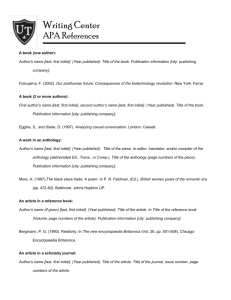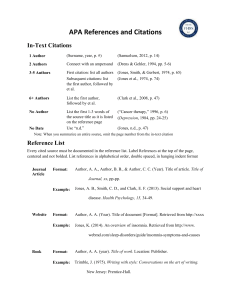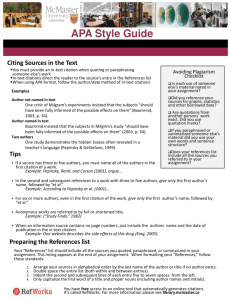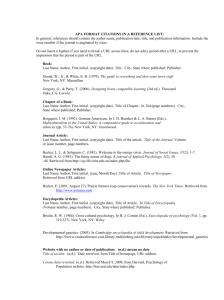APA Style: Beginner‟s Guide
advertisement
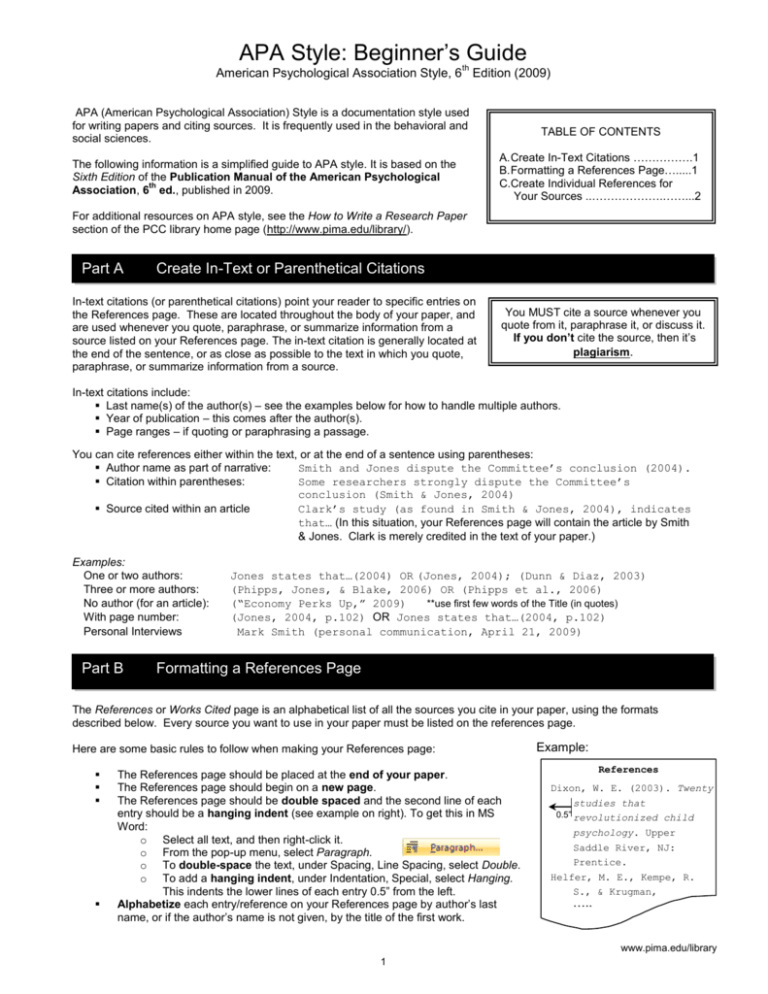
APA Style: Beginner‟s Guide th American Psychological Association Style, 6 Edition (2009) APA (American Psychological Association) Style is a documentation style used for writing papers and citing sources. It is frequently used in the behavioral and social sciences. The following information is a simplified guide to APA style. It is based on the Sixth Edition of the Publication Manual of the American Psychological th Association, 6 ed., published in 2009. TABLE OF CONTENTS A. Create In-Text Citations …………….1 B. Formatting a References Page….....1 C.Create Individual References for Your Sources ..……………….……...2 For additional resources on APA style, see the How to Write a Research Paper section of the PCC library home page (http://www.pima.edu/library/). Part A Create In-Text or Parenthetical Citations In-text citations (or parenthetical citations) point your reader to specific entries on the References page. These are located throughout the body of your paper, and are used whenever you quote, paraphrase, or summarize information from a source listed on your References page. The in-text citation is generally located at the end of the sentence, or as close as possible to the text in which you quote, paraphrase, or summarize information from a source. You MUST cite a source whenever you quote from it, paraphrase it, or discuss it. If you don’t cite the source, then it‟s plagiarism. In-text citations include: Last name(s) of the author(s) – see the examples below for how to handle multiple authors. Year of publication – this comes after the author(s). Page ranges – if quoting or paraphrasing a passage. You can cite references either within the text, or at the end of a sentence using parentheses: Author name as part of narrative: Smith and Jones dispute the Committee’s conclusion (2004). Citation within parentheses: Some researchers strongly dispute the Committee’s conclusion (Smith & Jones, 2004) Source cited within an article Clark’s study (as found in Smith & Jones, 2004), indicates that… (In this situation, your References page will contain the article by Smith & Jones. Clark is merely credited in the text of your paper.) Examples: One or two authors: Three or more authors: No author (for an article): With page number: Personal Interviews Part B Jones states that…(2004) OR (Jones, 2004); (Dunn & Diaz, 2003) (Phipps, Jones, & Blake, 2006) OR (Phipps et al., 2006) (“Economy Perks Up,” 2009) **use first few words of the Title (in quotes) (Jones, 2004, p.102) OR Jones states that…(2004, p.102) Mark Smith (personal communication, April 21, 2009) Formatting a References Page The References or Works Cited page is an alphabetical list of all the sources you cite in your paper, using the formats described below. Every source you want to use in your paper must be listed on the references page. Here are some basic rules to follow when making your References page: The References page should be placed at the end of your paper. The References page should begin on a new page. The References page should be double spaced and the second line of each entry should be a hanging indent (see example on right). To get this in MS Word: o Select all text, and then right-click it. o From the pop-up menu, select Paragraph. o To double-space the text, under Spacing, Line Spacing, select Double. o To add a hanging indent, under Indentation, Special, select Hanging. This indents the lower lines of each entry 0.5” from the left. Alphabetize each entry/reference on your References page by author‟s last name, or if the author‟s name is not given, by the title of the first work. 1 Example: References Dixon, W. E. (2003). Twenty studies that 0.5” revolutionized child psychology. Upper Saddle River, NJ: Prentice. Helfer, M. E., Kempe, R. S., & Krugman, ….. R.D.(1997). The battered child (5th ed). Chicago: www.pima.edu/library University of Chicago Press. Part C Create Individual References for Your Sources This section briefly explains how to cite the most commonly used resources as part of an APA References page. For more information, contact a PCC Librarian, or find th the Publication manual of the American Psychological Association (6 ed.) at your PCC campus library. Section Contents 1. FORMATTING FOR AUTHOR NAMES ........................................ 2 2. BOOKS ........................................ 2 3. ARTICLE OR CHAPTER IN A BOOK (Encyclopedias, Dictionaries, and Anthologies) ..... 3 4. ARTICLE IN A JOURNAL, MAGAZINE, OR NEWSPAPER... 3 5. WEB SITES ................................. 4 6. OTHER SITUATIONS ................. 4 General rules If your source lacks one of the ingredients in the recipe, you can ignore that ingredient and continue. For instance, if your book doesn‟t list an author, you can skip it and go on to the title. Pay close attention to capitalization and italicized text: o Book titles – Capitalize first word of title and subtitle that comes after a colon. Capitalize proper nouns. Italicize entire title. Example: Making learning whole: How seven principles of teaching can transform education HINT: Many library databases have o Article titles – capitalize first word of title and subtitle only. No italics. No citation tools that automatically quotation marks. No underlining. generate citations that you can copy Example: Appraising, researching and and paste into your paper. conceptualizing criminal thinking: A personal view o Journal titles – capitalize and italicize all words of the title. Example: Journal of Psychology For correct information, such as the book title, place of publication, and publisher, consult the title page of the book (not the book‟s cover). The copyright date is found on the next page, next to the © symbol, for example, © 2009 1. FORMATTING FOR AUTHOR NAMES When listing the author(s) of a source, a number of general rules should be followed across all publication formats. List an author‟s last name and use initials for the first and middle names. Include a space between the first and middle initial. Refer to the adjacent examples for different author conditions. One Author Two Authors Three to Six Authors Six or More Authors Organization as Author No Author Lopez, M. T. Lopez, M. T., & Fox, J. Lopez, M. T., Fox, J., & Moran, A. Harris, M., Karper, E., Stacks, G., Hoffman, D., DeNiro, R., Cruz, P., et al.(“et al.” means “and others.”) Pima Community College. <skip the author and begin with title> 2. BOOKS PRINTED BOOKS Author(s). (Year of publication). Title of book: Subtitle of book. Place of publication: Publisher. ELECTRONIC BOOKS (E-BOOKS) Author(s). (Year of publication). Title of book: Subtitle of book. Retrieved from <insert URL for e-Book> Type of Book Examples One Author Dixon, W. E. (2003). Twenty studies that revolutionized child psychology. Upper Saddle River, NJ: Prentice Hall. Multiple Authors Mash, E. J., & Wolfe, D. A. (1999). Abnormal child psychology. Belmont, CA: Brooks/Cole-Wadsworth. See Section 1. Formatting for Author Names, for additional formats. Book with editors instead of authors Torr, J. D. (Ed.). (2004). Crime and criminals. San Diego: Greenhaven Press. Book published in nd 2 or later edition Helfer, M. E., Kempe, R. S., & Krugman, R. D. (1997). The battered child (5th ed). Chicago: University of Chicago Press. Translator Berko, A. (2007). The path to paradise: The inner world of suicide bombers and their dispatchers (E. Yuval, Trans.). Westport, CT: Praeger Security International. (Original work published 2004). An edited book is a collection of articles or chapters, often written by various authors. It has an editor instead of an author. Use the example above if you are citing the book as a whole. To cite one of the articles in the book, see section 3, “Article or Chapter in a Book.” 2 Electronic Book Hersen, M., & Ammerman, R. T.(Eds.). (2000). Advanced abnormal child psychology (2nd ed). Retrieved from http://0www.netlibrary.com. (E-Book) library2.pima.edu/ 3. ARTICLE OR CHAPTER IN A BOOK (Encyclopedias, Dictionaries, and Anthologies) PRINT ARTICLE OR CHAPTER IN A BOOK OR ANTHOLOGY: Author(s). (Year of publication). Title of article/chapter. In Editors (Eds.), Title of book (pp. <insert page range>). Location: Publisher. ELECTRONIC ARTICLE OR CHAPTER IN A BOOK (found in library databases): Author(s). (Year of publication). Title of article/chapter. In Title of book (chapter or section number). Retrieved from <insert URL of database> PRINT MULTI-VOLUME BOOKS (e.g. encyclopedias): Author(s). (Year of publication). Title of article. In Title of book/encyclopedia (volume, pp. <insert page range>). Location: Publisher. ELECTRONIC MULTI-VOLUME BOOKS (e.g. encyclopedias): Author(s). (Year of publication). Title of article. In Editor (Ed.), Title of book/encyclopedia (volume, pp. <insert page range>). Retrieved from <insert URL of database> Type of Article Example Printed article or chapter from a book Brown, G. W. (2000). Emotion and clinical depression: An environmental view. In M. Lewis & J. M. Haviland-Jones (Eds.), Handbook of emotions (2nd ed., pp. 75-90). New York: Guilford Press. Electronic article or chapter from a book LeMay, M. C. (2007). Problems, controversies, and solutions. In Illegal immigration: A reference handbook (Ch. 2). Retrieved from http://0www.netlibrary.com Electronic article from an online reference book Baran, A., & Lifton, B. (2004). Adoption. In S. G. Post (Ed.), Encyclopedia of bioethics, (Vol. 1, pp. 68-74). Retrieved from http://0go.galegroup.com 4. ARTICLE IN A JOURNAL, MAGAZINE, OR NEWSPAPER ELECTRONIC ARTICLES (found in library databases): Author(s). (Year, Month Day if available). Title of article. Title of Publication, volume number(issue number), pp. <insert page range>. doi:0000000/000000000000 Author(s). (Year, Month Day if available). Title of article. Title of Publication, volume number(issue number), pp. <insert page range>. Retrieved from <insert URL of journal homepage> The “doi” is a Digital Object Identifier assigned to online articles. This is usually listed in the database record for the article. If your article does not have a “doi”, provide the URL of the journal homepage (see second example above). You may need to search on the journal title in google or another search engine to find the URL. PRINTED ARTICLES: If you have a source in printed format, use the following basic format: Author(s). (Year). Title of article. Title of Periodical, Volume number(issue number if available), <insert page range>. Type Example Online Journal Article with DOI (from a library database) Walters, G. (2006, June). Appraising, researching and conceptualizing criminal thinking: a personal view. Criminal Behaviour & Mental Health, 16(2), 87-99. doi:10.1002/cbm.50 3 Online Journal Article without DOI (from a library database) Viemero, V. (1996, March). Factors in childhood that predict later criminal behavior. Aggressive Behavior, 22(2), 87-97. Retrieved from http://www3.interscience.wiley.com/journal/32356/home Provide the URL of the journal homepage. You may need to search on the journal title in google or another search engine to find the URL. Online Magazine Article (from a library database) Lopez, F. (2007, October). Children's health: Managing ADHD during the school year. The Exceptional Parent, 37(10), 46. Retrieved from http://www.eparent.com/ Magazines generally have no volume or issue, so just include the Day, Month, and Year of publication. For magazines published monthly or quarterly, you only need to include the Month and Year. Online Newspaper Article (from a library database) Bell, J. (2009, August 17). Old friend helping Vick make new start. USA Today. Retrieved from http://www.usatoday.com Newspaper articles should have the full date of publication in the format (Year, Month Day) Jayson, S. (2006, June 29). The 'millennials' come of age. USA Today. Online Article Retrieved from http://www.usatoday.com from Newspaper or Magazine website 5. WEB SITES WEB SITES: Author(s). (Year, Month Day). Title of web page. Retrieved from <insert web URL> If there is no date, write n.d. If there is no author, begin with the Title of the web page and follow with the date. If a URL must be divided between two lines, break it only after a slash. Do not add a hyphen. Type Basic Web site On-line Technical or Research Report Example U.S. Food and Drug Administration. (2009, June 18). Cell phones. Retrieved from http://www.fda.gov/Radiation-EmittingProducts/ RadiationEmittingProductsandProcedures/HomeBusinessandEntertainment/ CellPhones/default.htm Jones, S., & Fox, S. (2009, Jan 28). Generations online in 2009. Retrieved from Pew Research Center, Pew Internet & American Life Project site: http://www.pewinternet.org/topics/Generations.aspx Note that the web address is preceded by a colon. Web site with no author or date International adoption: Getting started with international adoption. (n.d.) Retrieved from http://international.adoption.com/ 6. OTHER SITUATIONS Type Film (in DVD format) Example Martinelli, G., & Luhrmann, B.(Producers), & Luhrmann, B.(Director). (2006). Romeo + Juliet [Motion picture]. United States: Twentieth Century Fox Home Entertainment. For films, include the producers, director, year of publication, title of the film, followed by [Motion picture], country of publication, and distributor. Interview published in a daily newspaper Spears, B. (2002, December 2). Pop’s baddest good girl [Interview]. Hollywood Reporter, p. S6. TV program Lucas, T., & Cort, J. (Producers). (2006, October 31). Monsters of the Milky Way. [Television broadcast]. Boston: WGBH Educational Foundation. Digital Images Shahn, B. (1956). Sigmund Freud (painting). Private Collection, New York. Retrieved from ArtStor. Begin with the person being interviewed. If interview is found online, add URL of interview at end of entry. Do not include interviews conducted in person in your reference list. Cite personal interviews in-text only (see example under Part A – Create In-Text Citations). „Retrieved from‟ is the name of the database OR the URL of a website collection. 4

